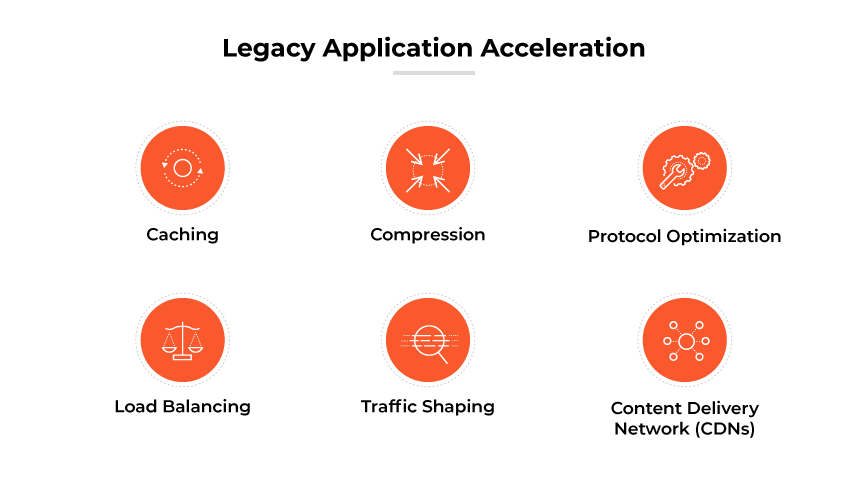What Is Application Acceleration?
Application acceleration is a longstanding technology process that enhances the speed and efficiency of application delivery and end-user interaction.
Application acceleration traditionally involved network optimization techniques including proactively optimizing wireless ‘first-mile’ connectivity and dynamic content acceleration. However, today’s workforces are predominantly wireless, and applications have become more personalized, utilizing real-time dynamic content tailored for each user. These changes call for a series of advancements in accelerating application performance and delivering consistent experiences.
How Does Legacy Application Acceleration Work?

Application acceleration traditionally worked by using a variety of optimization techniques to enhance the speed and efficiency of data transfer across a network to improve the performance of applications. Application acceleration works with web applications and applications used in local networks when enterprises initially began augmenting data centers with SASE and other web-based tools to optimize experiences.
Optimization techniques include:
1. Caching
Storing frequently accessed data closer to the user, such as on a local server or on the user’s device, to speed up data retrieval.2. Compression
Minimizing the size of data before transmission to reduce bandwidth usage and improve transfer speeds3. Protocol Optimization
Adjusting network protocols to streamline data transmission and reduce latency.4. Load Balancing
Distributing network or application traffic across multiple servers to prevent overloading and to ensure optimal performance.5. Traffic Shaping
Prioritizing certain types of network traffic over others to ensure critical data is transmitted efficiently.6. Content Delivery Networks (CDNs)
Using a network of distributed servers to deliver content more rapidly to users based on their geographic location.
These practices collectively helped mitigate the impact of factors like high latency and network congestion, enabling applications to perform more reliably and quickly. This approach worked well when all application data and content were static.
How Does Modern Application Acceleration Work?
Today, modern workforces are predominantly wireless. Geographically distributed and hybrid workforces mostly connect over cellular networks and Wi-Fi. However, cellular networks and Wi-Fi often suffer from intermittent jitter, data loss, and packet loss. Concurrently, applications and the content they serve have become increasingly dynamic, serving up real-time, personalized content for each user.
Dynamic content, computed in real time for each user, incurs a latency penalty at every request. Google’s Core Web Vitals refer to this as First Input Delay (FID). The response time is measurable per request in Chrome dev tools. The delay affects the end-user experience, as well as the overall efficiency and productivity of employees who may have to wait for dashboards and other features to load. Traditional network or content acceleration methods cannot reduce the latency tax because the content needs to be up to date; possibly even updated in real time.
Latency tax, coupled with the intermittent packet loss prevalent in wireless networks, creates inconsistent and poor end-user experiences. This paradigm represents the challenges of applications today that tactics like caching do not solve for.
Current challenges require a new, more modernized version of application acceleration. A modern application acceleration strategy must augment the functionality of legacy approaches.
Modern application acceleration technology should focus on adapting to hybrid-worker first-mile connectivity conditions to boost connection performance—without changing existing infrastructure, adding new hardware, or introducing complexity.
Since applications have changed, a modern approach to application acceleration should also take into consideration what each user is doing within an application, learning which APIs the user frequently calls upon and how the user interacts with the application to be able to fetch information more effectively.
Legacy Application Acceleration and WAN Optimization
Application acceleration fits within WAN optimization by enhancing the speed and efficiency of applications across a wide area network. It targets the reduction of latency and improves data transfer rates through techniques like caching, compression, and protocol optimization, which are key aspects of WAN optimization.
WAN optimization, as a broader category, includes application acceleration as one of its methods, focusing on optimizing the entire network's performance. It involves techniques to reduce traffic, prioritize business-critical information, and manage bandwidth effectively. Application acceleration specifically makes applications more responsive by addressing issues that slow down application performance, such as data redundancy, protocol chattiness, and packet loss.
By implementing application acceleration within WAN optimization strategies, enterprises can ensure applications perform optimally over long distances, which is critical in today's distributed work environments.
Application Acceleration Benefits
In the context of WAN optimization, application acceleration provides significant benefits by enhancing the speed and reliability of applications across wide area networks. This is crucial for distributed enterprise environments where rapid access to centralized applications and data is essential.
Application acceleration technologies such as caching, compression, and protocol optimization are integral to WAN optimization strategies. They reduce the amount of data traversing the network, minimize latency, and improve the end-user experience. These technologies work in concert to optimize the flow of application traffic, ensuring efficient use of bandwidth and faster delivery of content to end users.
The benefits of application acceleration within WAN optimization include improved application performance, reduced transmission times, and less bandwidth consumption. This leads to enhanced productivity, as applications become more responsive and available to users, regardless of their location. For businesses, this equates to improved operational efficiency, cost savings on bandwidth, and a better return on IT investments.
